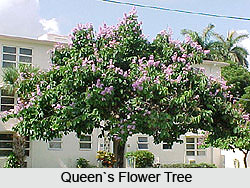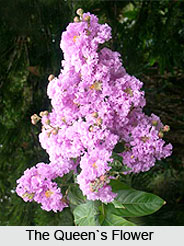 The `Queen`s Flower` tree, known as `Lagerstromia Speciosa` in science, is a very beautiful sight when in bloom. This is a member of the `Lythraceae` family and a common Indian tree. The Hindi speaking people call it as `Arjuna` or `Jarul`. It is known as `Jarul` in Bengali as well. The tree known as `Kadali` and `Pumarathu` in Tamil language. In Sinhalese, it is `Murutu` while it is named as `Bongor Raya` or `Sebokok` in Malayalam. The English people know it as `Queen`s Crepe Myrtle` or the `Pride of India`.
The `Queen`s Flower` tree, known as `Lagerstromia Speciosa` in science, is a very beautiful sight when in bloom. This is a member of the `Lythraceae` family and a common Indian tree. The Hindi speaking people call it as `Arjuna` or `Jarul`. It is known as `Jarul` in Bengali as well. The tree known as `Kadali` and `Pumarathu` in Tamil language. In Sinhalese, it is `Murutu` while it is named as `Bongor Raya` or `Sebokok` in Malayalam. The English people know it as `Queen`s Crepe Myrtle` or the `Pride of India`.
In the month of April, the flowers and leaves of the tree appear in a great style. At this time, the tree covers up with some fragile colours. The tree blooms until the month of July, when the hot season ends. It is justifiably popular in the gardens and also in villages.
When the tree is in its full bloom, the pale greens and multicoloured bunches of flowers stand out to relieve our eyes from the dense darkness of the jungle. The bark of the tree is grey and smooth and also squared with polish and cream. The tree is broad-leafed but the leaves fall so slow and steadily that it rarely becomes bare. The large and vertical pyramids of flowers appear in the Summer. Varying from trees to trees, they change their colours. In some trees they are of purple colour, in some others they are mauve. Sometimes, they take a pretty pinky-mauve colour while sometimes they also take the definite pink colour. They even become white in some special occasions. Usually, the new flowers contain a deeper colour, but the older or aged ones become fade and sometimes almost white by the course of time. The various shades of the flowers scatter along the sprays and give them a charming appearance. At the end, the buds are soft bluish-green.  They also have a touch of pink in them. The wavy sepals give them the look of the velvet jugs. Inside the flowers, six or seven of the sepals are very soft green in colour and they are revealed between the slim bases of the petals. These petals are very uneven and wrinkled and this is why the tree acquired its other name, the `Crepe Flower`. The whole flower calculates around 6.3 cm across and it has some yellow dotted stamens and also a long style that radiate from the centre. When the flowering season is over, the numerous fruits form, sitting like little green crab apples in the wasted calices. In the later part of the year, they turn black and remain in the tree for almost the rest of the year along with the next flowering and fruiting season.
They also have a touch of pink in them. The wavy sepals give them the look of the velvet jugs. Inside the flowers, six or seven of the sepals are very soft green in colour and they are revealed between the slim bases of the petals. These petals are very uneven and wrinkled and this is why the tree acquired its other name, the `Crepe Flower`. The whole flower calculates around 6.3 cm across and it has some yellow dotted stamens and also a long style that radiate from the centre. When the flowering season is over, the numerous fruits form, sitting like little green crab apples in the wasted calices. In the later part of the year, they turn black and remain in the tree for almost the rest of the year along with the next flowering and fruiting season.
Normally, the leaves of the tree grow alternating each other and sometimes in nearly making a pair. They also grow in all the directions of the branches. They are bright green in colour and a little pale below. Being heavily veined on the underside, each leaf is a smooth and pointed oval that measures from 12.5 to 20 cm in length and grows from a short stalk. Sometimes, they turn an eye-catching coppery shade just before they fall down in the Winter. They also give the tree a temporary charm provided the insects don`t disfigure them.
The timber of `Queen`s Flower` posses a great value that can be compared with that of the `Teak Tree` only. The wood is very tough and strong and it can also resist the effects of salty sea- water and sea air for many years. For this great quality only, in India it is used for making wharf posts, boats, casks, etc. With a fine polish, the timber can also be used for making panels on the wall as well as furniture. The country people found some medicinal values of the tree as well. According to them, the roots of the tree are astringent, the seeds are narcotic and the bark and leaves are strongly physique. However, the main reason of the people to cultivate the tree is the ability to be used frequently in decoration.











